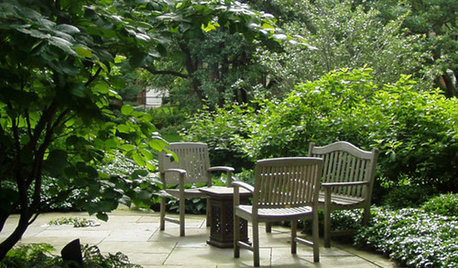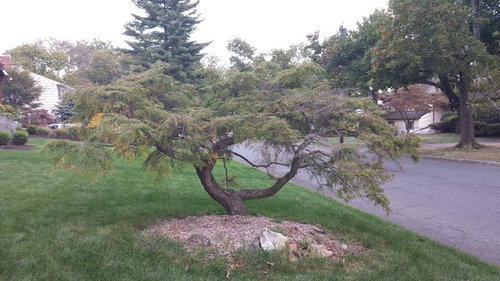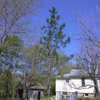Am I going to lose this weeping hemlock?
danielj_2009
8 years ago
Featured Answer
Sort by:Oldest
Comments (22)
Mike McGarvey
8 years agodanielj_2009
8 years agoRelated Discussions
I think I really am losing it!
Comments (2)Pauline, today a man walked into a store I was in and the owner asked him how he was. He replied present in body but not in mind. Sounds like me on any given day. You are too caring to worry about missing anything! Carla...See MoreAm I Going to Lose This Tree?
Comments (2)that is.. was.. a weak crotch .... the brown is where two branches swayed in the wind.. and caused a festering wound .... you can google the term .... maybe add tree.. if you want to talk about trees.. lol ... that said.. in my world its a goner... besides the fact that ash are susceptible to emerald ash borer ... and if i have it 15 miles north of the OH border.. you have it in OH .... get rid of it.. and start over with a better tree ... i love my oaks.. and i could refer you to a place in mansfield for quite a selection ... within the next 30 days.. is prime planting time for z 5-6 .... ken...See MoreBest weeping hemlock
Comments (33)I have 4 Sargent's in my garden and they are beautiful. But the one that gets the most sun ( 4 hours) look the best. The one that got the least (1 hour) was just OK and so I cut down a couple of poplars to provide more sun and it has responded. The photos above suggest that the plants get quite a bit of sun and so you need to factor in how much shade you have in your garden. Gary...See MoreA new weeping Hemlock for me.
Comments (9)My mix is woodchips, sand, and cow manure from my neighbor. I age it for at least a year. This year's mix was a little 'hot' so I diluted it with woodchips aged at least for three years. I mix it to what I think is just right and then test it out on some houseplants I repot in the sunroom. They tell me right away the condition of the potting soil. Coleus, in particular, because it's such a fast grower....See Moresc77 (6b MA)
8 years agodanielj_2009
8 years agowisconsitom
8 years agoken_adrian Adrian MI cold Z5
8 years agodanielj_2009
8 years agoSmivies (Ontario - 5b)
8 years agowisconsitom
8 years agobengz6westmd
8 years agodanielj_2009
8 years agodanielj_2009
8 years agomassimiliano_allegri
8 years agomassimiliano_allegri
8 years agodanielj_2009
8 years agoken_adrian Adrian MI cold Z5
8 years agorhizo_1 (North AL) zone 7
8 years agodanielj_2009
8 years agolast modified: 8 years agodanielj_2009
8 years agowisconsitom
8 years agoSue Hughes Zone 6b in Pittsburgh
5 years ago
Related Stories

KITCHEN DESIGNHow to Lose Some of Your Upper Kitchen Cabinets
Lovely views, display-worthy objects and dramatic backsplashes are just some of the reasons to consider getting out the sledgehammer
Full Story
EARTH DAYThe Case for Losing the Traditional Lawn
Work less, help the environment and foster connections by just saying no to typical turf
Full Story
MOST POPULAR7 Ways to Design Your Kitchen to Help You Lose Weight
In his new book, Slim by Design, eating-behavior expert Brian Wansink shows us how to get our kitchens working better
Full Story
DECORATING GUIDESLose It: How to Reuse, Recycle or Replace Your Sofa
Follow these tips and tricks to keep your worn-out couch from ending up in a landfill
Full Story
BEFORE AND AFTERSSee 6 Yards Transformed by Losing Their Lawns
Wondering whether a turf lawn is the best use of your outdoor space? These homeowners did, and they found creative alternatives
Full Story
BATHROOM DESIGNThe Glass Bathroom Wall: Love It or Lose It?
There's no question that a glass wall makes a bathroom feel more open. Are they private enough for you?
Full Story
GARDENING AND LANDSCAPINGYour Yard: Are You Ready to Lose the Lawn?
Save time and water with good-looking alternatives to turf grass
Full Story
DECORATING GUIDESLose It: How to Get Rid of Old Light Bulbs
When the light goes out, you'll want to get rid of the bulb safely. Here's how
Full Story
DECORATING GUIDESKeep Your Collectibles (Without Losing Your Sanity)
How to Display Your Finds With Wit and Style
Full Story
SAVING WATERHouzz Call: Are You Letting Go of Your Lawn?
Many facing a drought are swapping turf for less thirsty plantings. If you’re one of them, we’d like to hear about it
Full Story











wisconsitom